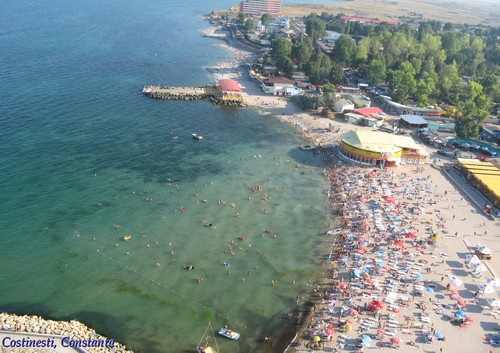
Romania traditionally has had a very low number of local tsunami events, that were poorly documented by usually being described by eye-witnesses and rarely measured by instruments.
Thus, according to http://www.profet.ro/Sectiunea%20A%20pag.%201-32.pdf, (which offers a sum of research articles of presentations which took place during of the International Seminar on Natural Hazards in the Marine Area, 28-29 July 2008, Bucharest, Romania), a sum of anomalous hydrodynamic events were observed: high waves at the entrance to the Sulina Canal and floods on jetties situated along the canal, displacements of rock blocks and violent displacement of ships anchored in Sulina harbor, etc. in 1957, 1958, 1960 and 1993. Geological studies in the area determined that tsunami-wave depositions were registered on the Black Sea Coast (Marine Natural Hazard: New Data About Tsunami Phenomena Along the Romanian Black Sea Coast). The most known trigger for tsunamis in the Black Sea bassin was identified to be earthquakes, followed by submarine landslides especially in the NW part of the bassin; many earthquakes, with magnitudes of 6.5 or more, were said to have their epicenters on the Black Sea coasts, being potential sources for future tsunamis. Overall, researchers have suggested (p. 27) that the entire Black Sea Coast should be considered as a possible tsunami target.

In 2011, Romanian scientists took part in establishing an early alert system for geological hazards on the Black Sea coast. According to http://www.novinite.com/articles/134566/Bulgaria,+Romania+to+Watch+Out+for+Black+Sea+Tsunamishttp://www.novinite.com/articles/134566/Bulgaria,+Romania+to+Watch+Out+for+Black+Sea+Tsunamis, a total of 10 tsunami stations will be placed on Romania and Bulgaria Black Sea Coast, which will observe seafloor vibrations - vibrations which will show whether earthquakes are about to take place and whether they can cause tsunami waves.
A total of 10 stations will be placed on Bulgaria and Romania's Black Sea aquatory as a part of the project.
"The stations will observe seafloor vibrations – vibrations which will show whether earthquakes are about to take place and whether the earthquakes can cause tsunami waves,
- See more at: http://www.novinite.com/articles/134566/Bulgaria,+Romania+to+Watch+Out+for+Black+Sea+Tsunamis#sthash.U1KX8ptR.dpuf
"The stations will observe seafloor vibrations – vibrations which will show whether earthquakes are about to take place and whether the earthquakes can cause tsunami waves,
- See more at: http://www.novinite.com/articles/134566/Bulgaria,+Romania+to+Watch+Out+for+Black+Sea+Tsunamis#sthash.U1KX8ptR.dpuf
Romanian
scientists will take part in establishing an early alert system for
geological hazards on the two countries' Black Sea coast. - See more at:
http://www.novinite.com/articles/134566/Bulgaria,+Romania+to+Watch+Out+for+Black+Sea+Tsunamis#sthash.U1KX8ptR.dpuf
Romanian
scientists will take part in establishing an early alert system for
geological hazards on the two countries' Black Sea coast. - See more at:
http://www.novinite.com/articles/134566/Bulgaria,+Romania+to+Watch+Out+for+Black+Sea+Tsunamis#sthash.U1KX8ptR.dpuf
Romanian
scientists will take part in establishing an early alert system for
geological hazards on the two countries' Black Sea coast. - See more at:
http://www.novinite.com/articles/134566/Bulgaria,+Romania+to+Watch+Out+for+Black+Sea+Tsunamis#sthash.U1KX8ptR.dpuf
In 2014, according to the Intergovernmental Oceanographic Commission, http://www.ioc-tsunami.org/http://www.ioc-tsunami.org/, the tsunami alert exercise that took place from the 28 to the 30 October
in the Mediterranean, North-eastern Atlantic, and the Black Sea was marked by a strong participation of the civil protection
authorities in a number of countries that never participated before, among which Romania. This simulation aimed at t esting the preparedness of the countries participating in the NEAMTWS (Tsunami Early Warning and Mitigation System in the North-eastern Atlantic, the Mediterranean and connected seas) established by the IOC (Intergovernmental Oceanographic Commission) of UNESCO. For Romania, this exercise was not only the first time it participated to such an exercise but also the first occasion to establish contracts among the actors concerned with tsunami risk at national level.
esting the preparedness of the countries participating in the NEAMTWS (Tsunami Early Warning and Mitigation System in the North-eastern Atlantic, the Mediterranean and connected seas) established by the IOC (Intergovernmental Oceanographic Commission) of UNESCO. For Romania, this exercise was not only the first time it participated to such an exercise but also the first occasion to establish contracts among the actors concerned with tsunami risk at national level.The exercise, named NEAMWave14, simulated 4 earthquakes generating tsunamis in the Mediterranean, north-eastern Atlantic, and Black Sea and involved the simulation of the assessment of a tsunami, based on an earthquake-driven scenario followed by alert message dissemination.

exercises like that one you mention in 2014 are so important! the more you rehearse, the better prepared you are. I am assuming coordinating with numerous countries cannot be easy but if a tsunami hits, that might be the only solution.
ReplyDeletegreat post. It is good to know that your country is generally prepared when a tsunami hits. After all, tsunamis come without warning, so its hard to truly be ready for this kind of disaster.
ReplyDelete